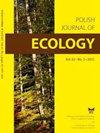作为濒危高山玫瑰繁殖材料的光榆枯死木材中的真菌群(鞘翅目:Cerambycidae)
IF 0.7
4区 环境科学与生态学
Q4 ECOLOGY
引用次数: 1
摘要
摘要腐生真菌在木材中的存在对食木昆虫至关重要,因为它们会改变其化学成分、水分含量和结构,从而控制幼虫的存活和生长速度。关于真菌生物群在腐叶植物繁殖材料上定居的情况知之甚少。本文以枯死的白榆的分枝菌群为研究对象,对濒危的高山玫瑰进行了繁殖。利用分子技术鉴定了从育种材料的木材碎片中分离出的真菌。共发现木材腐朽真菌24个分类群(子囊菌门16个,担子菌门6个,接合菌门1个,1个未鉴定)——腐生菌和兼性寄生虫、腐生真菌、真菌寄生虫和树木寄生虫。从木材的表层和深层,以及从高山乳杆菌觅食地留下的木尘和碎屑中分离出六个分类群:枝孢霉、枝孢霉属、缺氧大果霉、Phaeoacremium fraxinopennsylvanicum、Sistotrema brinkmannii和厚毛Stereum。这些真菌可能对高山乳杆菌在枯死或垂死的树木上定居并影响其幼虫发育至关重要。在波兰首次报道了黄曲霉(Ph.fraxinopennsylvanicum)、大果黄曲霉(H.macrocarpum)和儿童达尔迪尼亚(Daldinia childiae)。本文章由计算机程序翻译,如有差异,请以英文原文为准。
Mycobiota of Dead Ulmus glabra Wood as Breeding Material for the Endangered Rosalia alpina (Coleoptera: Cerambycidae)
ABSTRACT The presence in wood of saprotrophic fungi is crucial for xylophagous insects, as they modify its chemical composition, moisture content and structure, and thus govern the survival and growth rate of larvae. Little is known about the mycobiota colonising the breeding material of saproxylic species. This paper focuses on the mycobiota of dead wych elms Ulmus glabra as breeding material for the endangered Rosalia alpina. Fungal isolates from wood fragments of the breeding material were identified using molecular techniques. A total of 24 taxa of wood-decay fungi were found (16 Ascomycota, 6 Basidiomycota, 1 Zygomycota, 1 unidentified) – saprotrophs and facultative parasites, saprotrophic fungi, fungal parasites and tree parasites. Six taxa were isolated from both the surface and deeper layers of the wood, and also from the wood dust and frass left in R. alpina foraging sites: Cladosporium cladosporioides, Cladosporium sp., Hypoxylon macrocarpum, Phaeoacremonium fraxinopennsylvanicum, Sistotrema brinkmannii and Stereum hirsutum. These fungi may be crucial in enabling R. alpina to colonise dead or dying trees and affect its larval development. Ph. fraxinopennsylvanicum, H. macrocarpum and Daldinia childiae are reported for the first time from Poland.
求助全文
通过发布文献求助,成功后即可免费获取论文全文。
去求助
来源期刊

Polish Journal of Ecology
环境科学-生态学
CiteScore
1.10
自引率
0.00%
发文量
9
审稿时长
18-36 weeks
期刊介绍:
POLISH JOURNAL OF ECOLOGY (formerly Ekologia polska) publishes original scientific research papers dealing with all aspects of ecology: both fundamental and applied, physiological ecology, evolutionary ecology, ecology of population, community, ecosystem, landscape as well as global ecology. There is no bias regarding taxons, ecosystems or geographical regions.
 求助内容:
求助内容: 应助结果提醒方式:
应助结果提醒方式:


